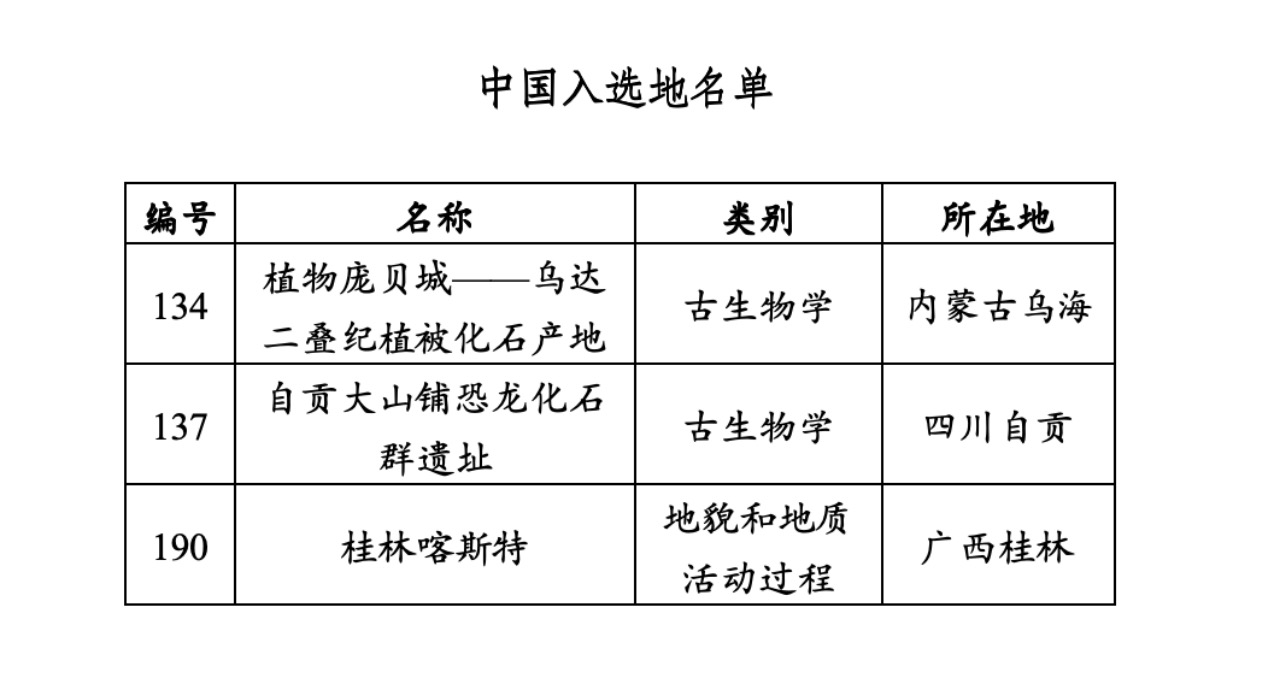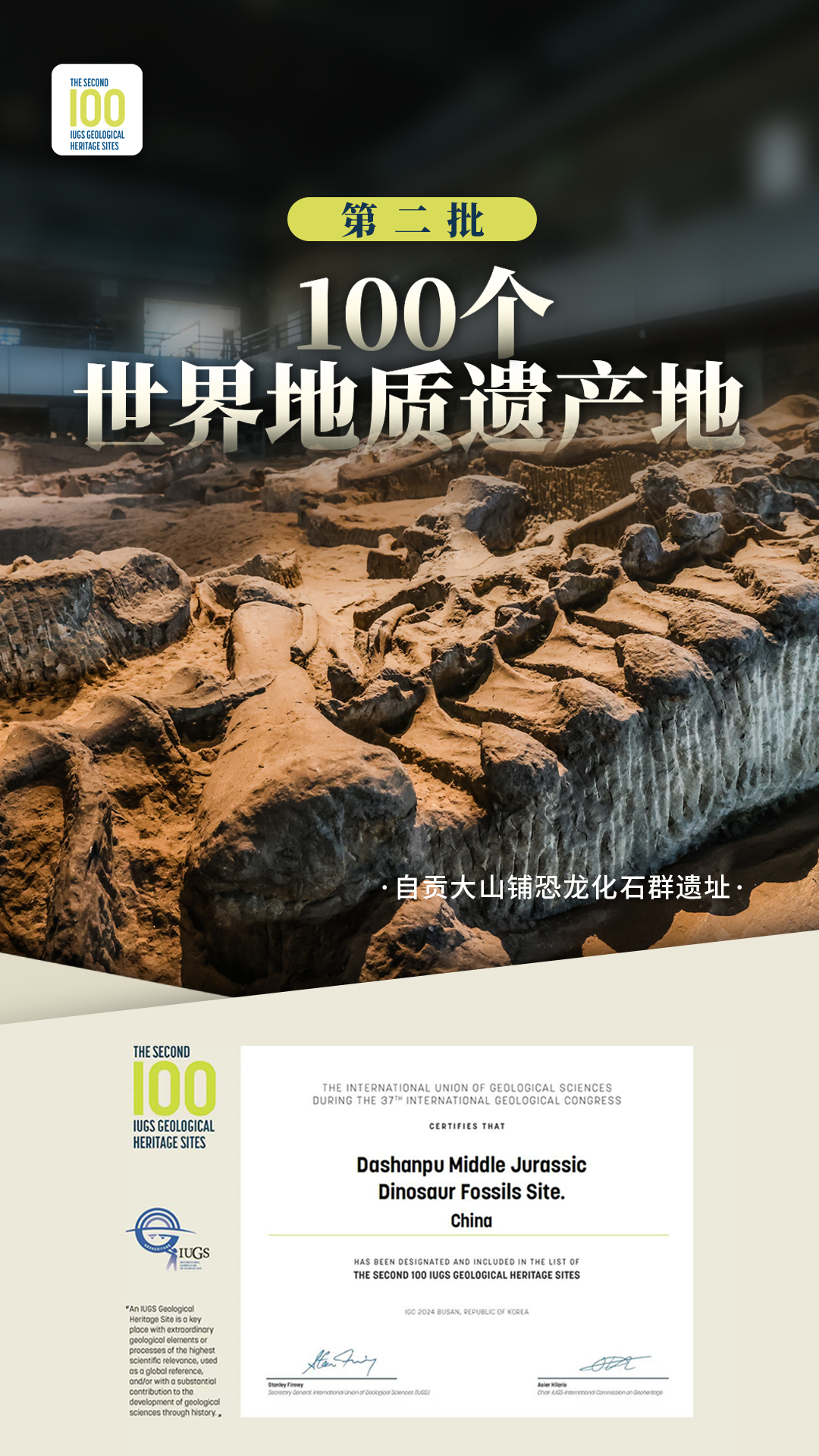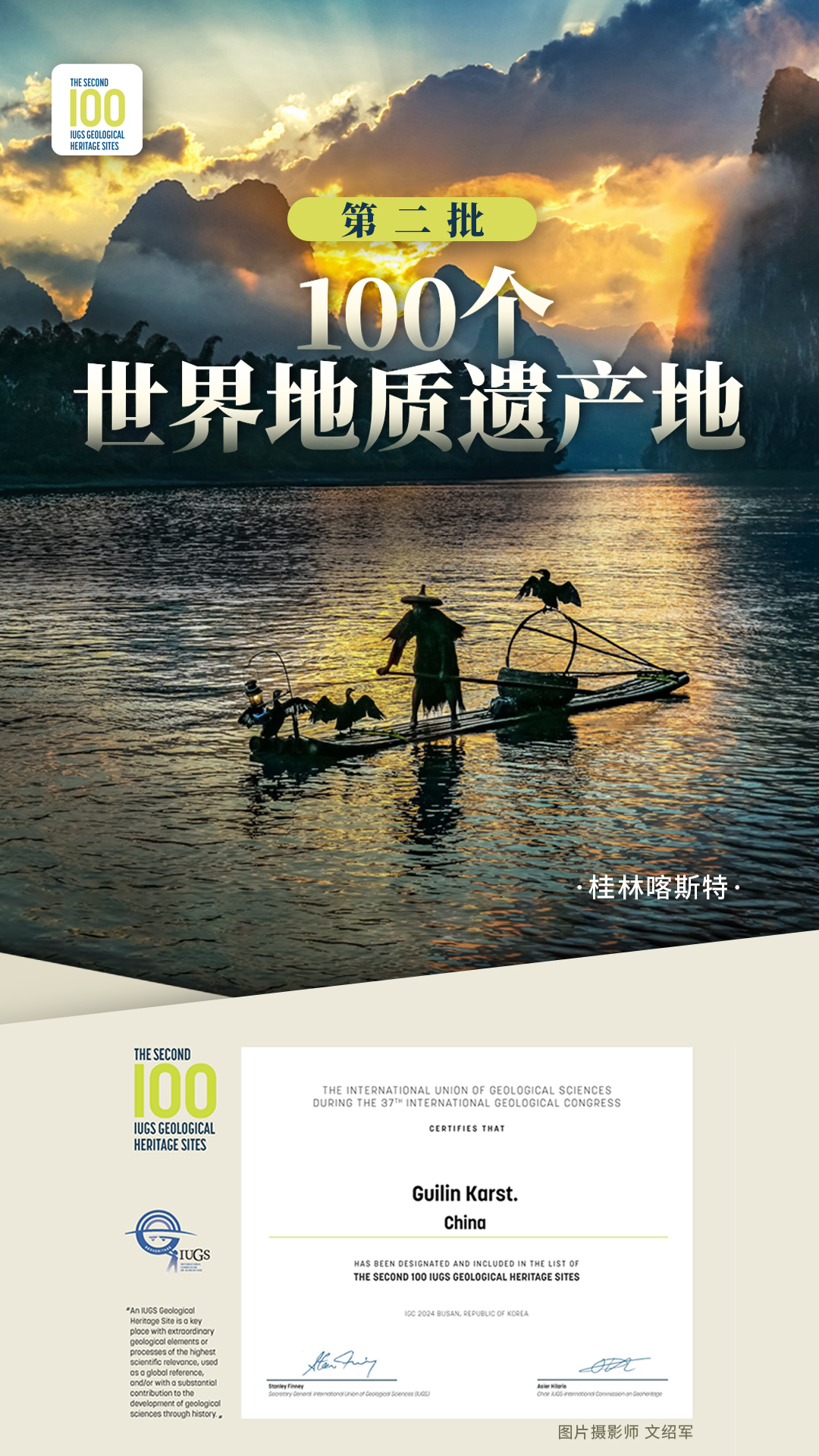

China's selected heritage sites in the global second batch of 100 geological heritage sites list.
Each of the three locations in China—Uzhhorod in Inner Mongolia, Zigong in Sichuan, and Guilin in Guangxi—has been included in the second batch of 100 geological heritage sites by the International Union of Geological Sciences (IUGS).
On the morning of September 3, at a news conference hosted by the Nanjing Institute of Geology and Palaeontology of the Chinese Academy of Sciences, Zhang Jianping, Vice Chairman of the IUGS International Heritage Committee and Professor at China University of Geosciences (Beijing), announced the news.
Selection criteria for IUGS heritage sites include “maximum” scientific relevance, “extraordinary” geological processes, “critical” locations that serve as “global” references, uniqueness, “best” representation, and/or “significant” contributions to the history of geological science.
Geological heritage represents irreplaceable and precious records of Earth’s 4.6 billion-year evolutionary history and serves as a field base for geologists conducting scientific research.
The specific Chinese sites in the second batch are: “Plant Pompeii—Uda Permian Vegetation Fossil Site” (Inner Mongolia), “Zigong Dashanpu Dinosaur Fossil Site” (Sichuan), and “Guilin Karst” (Guangxi). These sites pertain to fields such as paleobiology, geomorphology, and geological processes.
At the press conference, Wang Jun, Director of the Nanjing Institute of Geology and Palaeontology, Zeng Xiaoyun, Director of the Zigong Dinosaur Museum, and Chen Weihai, Chief Engineer of the Karst Geology Research Institute of the China Geological Survey, introduced the details of their respective geological heritage sites.
The global second batch of 100 geological heritage sites was announced during the 37th International Geological Congress held in Busan, South Korea, from August 25 to 31.
The IUGS, established in 1961, is the largest and most authoritative geological science organization in the world, currently representing 121 member countries and regions, encompassing over a million geoscientists globally. It is also an official partner of UNESCO.
According to previous reports by The Paper, in October 2022, the first global batch of 100 geological heritage sites was announced, among which seven Chinese geological heritage sites were selected: the Ordovician rocks of Mount Everest, the Permian/Triassic extinction and “golden spikes” at Coal Mountain, Changxing, Zhejiang, the Cambrian fossil site and fossil beds in Chengjiang, Yunnan, the Early Cretaceous acidic volcanic columns in Hong Kong, the décollement structure system in the Rongbuk Gorge of southern Tibet, the Kunming Stone Forest Karst in Yunnan, and the towering sand dunes and lakes of the Badain Jaran Desert, Inner Mongolia.
List of Selected Chinese Heritage Sites from the Global Second Batch of 100 Geological Heritage Sites:
The number for the “Plant Pompeii—Uda Permian Vegetation Fossil Site” is 134;
The number for the “Zigong Dashanpu Dinosaur Fossil Site” is 137;
The number for the “Guilin Karst” is 190.

1. “Plant Pompeii—Uda Permian Vegetation Fossil Site”—A Magnificent Tropical Coal Swamp Forest Preserved by Volcanic Ash
Located in Uzhhorod, Inner Mongolia, the Uda Permian vegetation fossil site is a unique burial record of coal-forming forests from geological history, also known as “Plant Pompeii.”
This coal-forming forest was preserved between two coal seams in the Uda coalfield, where it was covered by volcanic ash. High-precision zircon dating results from the volcanic ash indicate that the age of this coal-forming forest is approximately 298.34±0.09 million years, very close to the age of the Carboniferous-Permian boundary, making it the earliest reported Permian coal forest.
All parts of the plants are preserved in remarkably complete forms, with some structures being mineralized to retain the internal anatomical features of the plants. The flora consists of seven major groups, including lycopods, sphenopsids, ferns, seed ferns, and early gymnosperms, representing nearly all modern plant groups except for angiosperms. Many fossils also document interactions between insects and plants (such as feeding) as well as inter-plant interactions (like climbing), capturing the complex details of tropical rainforest communities and their ecological interactions during geological history. This unique “Permian coal-forming forest” provides a window into the Earth's ecology of the Late Paleozoic and was featured in the journal Science under the title “Ancient Land Emerges from Volcanic Ash: Buried in Coal, ‘Plant Pompeii’ Offers New Insights into the Ecosystem Structure and Climate of the Permian Period.”
The Uda Permian vegetation fossil site comprises a large number of reconstructed fossil plants, offering a vividly reconstructed view of the coal-forming forest landscape and providing a unique window into the community ecology of geological history. The Uda Permian vegetation fossil site was first discovered in 1998, but was not recognized as volcanic in origin until 2003. Since then, an international research team of about 30 experts from the UK, the USA, the Czech Republic, Germany, and China has published over 60 papers on its taxonomy, ecology, and geology, and studies are ongoing.
Currently, Uzhhorod’s “Plant Pompeii” boasts five world records: the largest area of ancient forest restoration, the richest collection of contemporaneous coal flora fossils, the oldest cycad plants, the richest group of peltate leaf plant species, and the highest number of entirely reconstructed fossil plants, thus greatly contributing to the evolutionary “tree of life” in paleontology with numerous new species.

2. “Zigong Dashanpu Dinosaur Fossil Site”—The Most Dense Middle Jurassic Dinosaur Fossil Site with Highly Diverse Vertebrate Fauna
The Zigong Dashanpu Dinosaur Fossil Site, located at the northeastern end of the Ziliujing Anticline in the Sichuan Basin, is part of a renowned red basin in southern China, featuring a sequence of continental strata ranging from the late Triassic to early Cretaceous. The dinosaur-bearing stratum is about 180 meters thick and belongs to the Lower Shaximiao Formation, composed mainly of lake and river sediment with purple-red mudstone interbedded with yellow-gray or gray-green medium to fine-grained feldspar-quartz sandstone or feldspar lithic sandstone. Dinosaur fossils are concentrated within 3-5 meters of grayish-green fine-grained feldspar sandstone found in the lower part of the Shaximiao Formation.
To date, more than 200 dinosaur and other vertebrate fossils have been excavated. Of these, 26 genera and 29 species have been identified, including sauropods, basal ornithischians, stegosaurids, fish, amphibians, turtles, crocodyliforms, plesiosaurs, pterosaurs, and mammal-like reptiles, thus forming a highly diverse vertebrate fauna from the Middle Jurassic.
This site represents the densest concentration of Middle Jurassic dinosaur fossils and features a highly diverse vertebrate fauna. In addition to being a type locality for the Shulong fauna, many basal groups, such as the true sauropods (Li’s Shulong), the large-nosed dinosaurs (Dong’s Dashanpuosaurus), the stegosauroids (Taibai Huayangosaurus), and the new ornithischians (Lao’s Linglongosaurus), are all representative of their respective categories. The site has also yielded some unique dinosaur skeletal structures, such as the tail club of a sauropod and shoulder spikes of a stegosaur, which are crucial for inferring dinosaur behavior. The Dashanpu dinosaur fossil site fills certain gaps in the evolutionary history of dinosaurs and provides excellent specimens for studying dinosaurs and their relationships with other vertebrates.
The Dashanpu dinosaur fossil site covers an area of approximately 70,000 square meters and was first discovered in 1972. Subsequently, the Dashanpu site museum was established—the Zigong Dinosaur Museum, which is the first specialized dinosaur museum in Asia. Scientists from both domestic and international backgrounds have conducted extensive and in-depth studies at the site, resulting in over 10 monographs, 5 special issues, and more than 100 academic papers being published.
The Dashanpu dinosaur fossil site was recognized as a Geopark of Zigong in 2008.

3. “Guilin Karst”—A Model of Continental Tower Karst (Peak Forest)
The Guilin Karst in Guangxi is situated in the central part of the Nanling Tectonic Belt, within the Devonian to Lower Carboniferous limestone area, boasting a limestone stratum thickness of up to 3000 meters. Its main features include the striking tower and cone karst topography around the beautiful Li River and its tributaries, along with numerous caves. Influenced by Paleozoic tectonic movements, the Guilin Karst consists of anticlines and synclines, forming a unique karst development basin.
Thick carbonate rock, a warm and humid climate, and abundant rainfall have collectively fostered intense karst development. Since the Quaternary period, the differential uplift of this region has sculpted the diversity of its landforms, primarily resulting in two types of karst landforms: tower karst and cone karst. Tower karst, or “surface flow karst,” predominates in low-lying areas, where exogenous water causes lateral erosion.
In contrast, cone karst, or “vertical seepage karst,” occurs in higher elevations with deeper groundwater levels, where precipitation infiltrates and causes vertical erosion. The “Guilin model” is a prime example of this dynamic karst development process, showcasing the continuous evolution of karst characteristics. Unlike the rapidly uplifting Yunnan-Guizhou Plateau, the geological strata of the Guilin area are stable, and the tectonic uplift is relatively slow, enhancing its scientific significance and establishing it as an important reference for global karst research.
The Guilin Karst is a classic representation of continental tower karst (peak forest), showcasing the landform display of Kajis’s end-stage karst evolution in South China. Situated in an exogenous water basin, its geological context shapes unique karst development, making it a representative area for studying karst processes and their environmental impacts. The “Guilin model” illustrates the coexistence and interaction between peak forest and peak cluster karst forms, possessing international scientific significance.
Research on Guilin karst dates back to the 17th century, when Xu Xiake explored 88 caves and coined the terms “peak forest” and “peak cluster.” Contemporary studies emphasize further understanding of karst dynamics, establishing co-evolution models for “peak clusters” and “peak forests,” as well as their aesthetic value impacting Chinese painting and poetry.
The Guilin karst was designated as a World Natural Heritage site as part of the South China Karst in 2007.